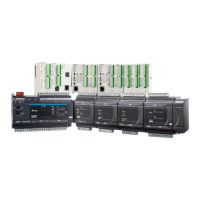Chapter 5 CPU and Module Devices
5-7
The PLC uses four types of values to execute the operation according to different control purposes.
1. Binary number (BIN)
The PLC uses the binary system to operate on the values.
2. Octal number (OCT)
DVP-PLC uses the octal number on the external inut and output device number. For example:
External input device number: X0~X7, X10~X17, to X377.
External output device number: Y0~Y7, Y10~Y17, to Y377.
3. Decimal number (DEC)
The PLC uses decimal numbers for:
T
he setting value of a timer (T) or the setting value of a counter (C/HC); for example, TMR C0 50 (constant K).
The device number S, M, T, C, D, E; for example, M10 and T30 (device number)
The constant K, used as the operand in an applied instruction. For example, MOV 123 D0 (constant K).
4. Binary-coded decimal (BCD)
A decimal value that is represented by a nibble or four bits so that sixteen consecutive bits represent a four-digit
decimal value.
5. Hexadecimal number (HEX)
The PLC uses hexadecimal numbers for:
The constant 16#, used as the operand in an applied instruction; for example, MOV 16#1A2B D0
(hexadecimal constant).
The following table shows the corresponding values.
Binary Number
(BIN)
Octal Number
(OCT)
Decimal Number
(DEC)
Binary Code Decimal
(BCD)
Hexadecimal Number
(HEX)
PLC internal
X and Y device
number
Constant K,
BCD related
Constant 16#,
0101 5 0101 5
1110 14 - E

